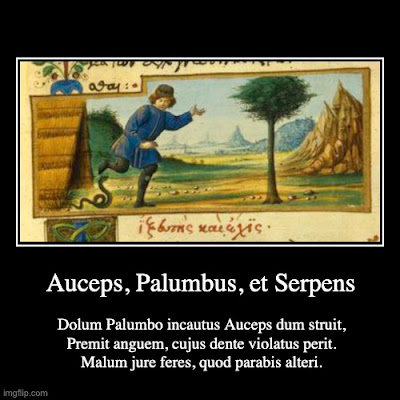This project has moved to a blog of its own: Fabulae Aesopi.
This continues my series of posts about the Latin verse fables of Desbillons; for more about Desbillons, see the starting post. I'm working through the poems book by book with indexes to each of the individual fables; this is the post for Book 3.
For each book, I am picking out one very short poem as the focus. So, you'll find a poem-by-poem index to Book 3 below (linking to the pages at the Internet Archive), and here's the poem I selected from that book, just 3 lines long, and it belongs to the classical Aesopic tradition.
3.20 Auceps, Palumbus, et Serpens
Dolum Palumbo incautus Auceps dum struit,
Premit anguem, cujus dente violatus perit.
Malum jure feres, quod parabis alteri.
Here is the poem written out in English prose order to help in reading:
Incautus Auceps,
dum struit dolum Palumbo,
premit anguem,
cujus dente violatus
perit.
Jure
feres [hoc] malum
quod parabis alteri.
Even though Palumbo is capitalized, the bird does not actually make an appearance in the story (at least not in this version!), while the snake is not capitalized ("anguem") so that it becomes more of an object rather than a proper character in the story. I'm not sure what I think about that; in fact, I'd be inclined to go the other way and write "Anguem" capitalized and "palumbo" lower-case. Those conventions will be something to ponder as this anthology takes shape, since I think it would be good to follow a similar convention across the different story-poems even when they are coming from different sources.
The "au" in "auceps" is a shortened form of "avis" in the sense that he is the bird-catcher (avis-capere). You can read about the bird called "palumbus" at the Wiktionary, which features this picture:
The meter is iambic, and here is some help with the meter (for more about iambic meter, see the post about Desbillons 1.1).
You can find illustrations for the fable here. Here's one from the Medici Aesop, and I used imgflip to make it a graphic:
More poems in Desbillons, Book 3:
1. sol et aquilo (lines: 15)
2. agricola et ciconia (lines: 14)
3. piscator et pisciculus (lines: 7)
4. membra et venter (lines: 15)
5. canis et bos (lines: 7)
6. puer et fortuna (lines: 4)
7. camelus et Iupiter (lines: 8)
8. lupus et haedus (lines: 8)
9. oves et lupi (lines: 10)
10. vulpis et caper (lines: 20+)
11. mulier et gallina (lines: 7)
12. cancer et vulpis (lines: 7)
13. musicus (lines: 11)
14. asinus et canis (lines: 20+)
15. bos et vitula (lines: 6)
16. leo filiam rustici amans (lines: 16)
17. culex, leo et aranea (lines: 16)
18. columbae et accipiter (lines: 7)
19. simia et vulpis (lines: 8)
20. auceps, palumbus, et serpens (lines: 3)
21. asellus eiusque herus (lines: 9)
22. taurus et caper (lines: 11)
23. corvus et urna (lines: 7)
24. venator et leo (lines: 11)
25. corvus et serpens (lines: 8)
26. rustici et sarmenta (lines: 8)
27. avis, eiusque pulli, et villicus (lines: 15)
28. crocodilus et vulpis (lines: 5)
29. ursus, leo, et lupus (lines: 16)
30. asinus dominos mutans (lines: 19)
31. aper et cerva (lines: 9)
32. asinus et equus (lines: 11)
33. Aethiops (lines: 11)
34. muscae (lines: 6)
35. vespertilio et mustelae duae (lines: 20+)
36. haedus et lupus (lines: 6)
37. tubicen et hostes (lines: 11)
38. accipiter et cuculus (lines: 14)
39. capones duo (lines: 16)
40. aranea et hirundo (lines: 18)
41. vulpis et ericius (lines: 14)
42. struthiocamelus altum volandi cupidus (lines: 12)
Dolum · Palum · b~ incau · tus Au · ceps dum · struit,
Premit an · guem, cuj · us den · te vio · latus · perit.
Malum · jure fe · res, quod · para · bis al · teri.
You can find illustrations for the fable here. Here's one from the Medici Aesop, and I used imgflip to make it a graphic:
1. sol et aquilo (lines: 15)
2. agricola et ciconia (lines: 14)
3. piscator et pisciculus (lines: 7)
4. membra et venter (lines: 15)
5. canis et bos (lines: 7)
6. puer et fortuna (lines: 4)
7. camelus et Iupiter (lines: 8)
8. lupus et haedus (lines: 8)
9. oves et lupi (lines: 10)
10. vulpis et caper (lines: 20+)
11. mulier et gallina (lines: 7)
12. cancer et vulpis (lines: 7)
13. musicus (lines: 11)
14. asinus et canis (lines: 20+)
15. bos et vitula (lines: 6)
16. leo filiam rustici amans (lines: 16)
17. culex, leo et aranea (lines: 16)
18. columbae et accipiter (lines: 7)
19. simia et vulpis (lines: 8)
20. auceps, palumbus, et serpens (lines: 3)
21. asellus eiusque herus (lines: 9)
22. taurus et caper (lines: 11)
23. corvus et urna (lines: 7)
24. venator et leo (lines: 11)
25. corvus et serpens (lines: 8)
26. rustici et sarmenta (lines: 8)
27. avis, eiusque pulli, et villicus (lines: 15)
28. crocodilus et vulpis (lines: 5)
29. ursus, leo, et lupus (lines: 16)
30. asinus dominos mutans (lines: 19)
31. aper et cerva (lines: 9)
32. asinus et equus (lines: 11)
33. Aethiops (lines: 11)
34. muscae (lines: 6)
35. vespertilio et mustelae duae (lines: 20+)
36. haedus et lupus (lines: 6)
37. tubicen et hostes (lines: 11)
38. accipiter et cuculus (lines: 14)
39. capones duo (lines: 16)
40. aranea et hirundo (lines: 18)
41. vulpis et ericius (lines: 14)
42. struthiocamelus altum volandi cupidus (lines: 12)


No comments:
Post a Comment
Comments are limited to Google accounts. You can also email me at laurakgibbs@gmail.com or find me at Twitter, @OnlineCrsLady.